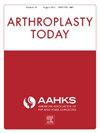Intraprosthetic Dislocation Following Dual Mobility Total Hip Arthroplasty: A Retrieval Analysis Study
IF 1.5
Q3 ORTHOPEDICS
引用次数: 0
Abstract
Background
Dual mobility (DM) implants in total hip arthroplasty provide excellent range of motion with low dislocation rates. A complication of this design is intraprosthetic dislocation (IPD), where the polyethylene (PE) liner dissociates from the femoral head. In older designs, IPD occurred due to a small head size and late PE wear with head-capture-mechanism failure. Routine retrieval analysis identified concerns regarding IPD of modern implants, and scant reporting in the literature led to this retrospective study.
Methods
A total of 124 (110 primary, 14 revision) DM implants (mean in situ time 2.0 ± 3.1 years) revised by 20 surgeons across Western Australia between July 2014 and August 2023 were assessed. Demographics, clinical information, mechanisms of failure, and observations at revision arthroplasty were analyzed. The retrieval analysis included an assessment of metal and PE wear mechanisms, corrosion between modular components, and extent of bony attachment to acetabular shells.
Results
There were 11 cases of IPD. Of these, 8 (73%) had a documented preceding failed closed reduction, with the remaining 3 revised due to trunnionosis, loosening, and joint instability. Nine out of 11 (82%) cases were female. Although metallic wear and inner-lip impingement of PE bearings were observed, there was no obvious failure mechanism for the other 3 retrieved IPD implants.
Conclusions
Most cases of IPD in DM implants occur after failed closed reduction in the setting of a hip dislocation, suggesting an iatrogenic cause of IPD. No implant-related features could be defined for the remaining cases. Recognizing common failure modes can help with the prevention and treatment of this complication.
双活动全髋关节置换术后假体内脱位:一项检索分析研究。
背景:双活动(DM)假体在全髋关节置换术中提供良好的活动范围和低脱位率。这种设计的一个并发症是假体内脱位(IPD),聚乙烯(PE)衬垫与股骨头分离。在较早的设计中,IPD的发生是由于头部尺寸小和后期PE磨损以及头部捕获机制失效。常规检索分析确定了对现代植入物IPD的关注,文献报道不足导致了这项回顾性研究。方法:对2014年7月至2023年8月期间由西澳大利亚州20名外科医生翻修的124例(110例原发性,14例翻修)DM种植体(平均原位时间2.0±3.1年)进行评估。分析了人口统计学、临床信息、失败机制和关节置换术的观察结果。检索分析包括评估金属和PE磨损机制,模块组件之间的腐蚀以及骨附着到髋臼壳的程度。结果:11例IPD。其中,8例(73%)患者先前有记录的闭合复位失败,其余3例因耳膜萎缩、松动和关节不稳定而进行了复位。11例中有9例(82%)为女性。虽然观察到PE轴承的金属磨损和内唇撞击,但其他3个回收的IPD种植体没有明显的失效机制。结论:大多数DM植入物的IPD发生在髋关节脱位闭合复位失败后,提示IPD的医源性原因。其余病例无植入物相关特征。认识常见的失效模式有助于预防和治疗这种并发症。
本文章由计算机程序翻译,如有差异,请以英文原文为准。
求助全文
约1分钟内获得全文
求助全文
来源期刊

Arthroplasty Today
Medicine-Surgery
CiteScore
2.90
自引率
0.00%
发文量
258
审稿时长
40 weeks
期刊介绍:
Arthroplasty Today is a companion journal to the Journal of Arthroplasty. The journal Arthroplasty Today brings together the clinical and scientific foundations for joint replacement of the hip and knee in an open-access, online format. Arthroplasty Today solicits manuscripts of the highest quality from all areas of scientific endeavor that relate to joint replacement or the treatment of its complications, including those dealing with patient outcomes, economic and policy issues, prosthetic design, biomechanics, biomaterials, and biologic response to arthroplasty. The journal focuses on case reports. It is the purpose of Arthroplasty Today to present material to practicing orthopaedic surgeons that will keep them abreast of developments in the field, prove useful in the care of patients, and aid in understanding the scientific foundation of this subspecialty area of joint replacement. The international members of the Editorial Board provide a worldwide perspective for the journal''s area of interest. Their participation ensures that each issue of Arthroplasty Today provides the reader with timely, peer-reviewed articles of the highest quality.
 求助内容:
求助内容: 应助结果提醒方式:
应助结果提醒方式:


